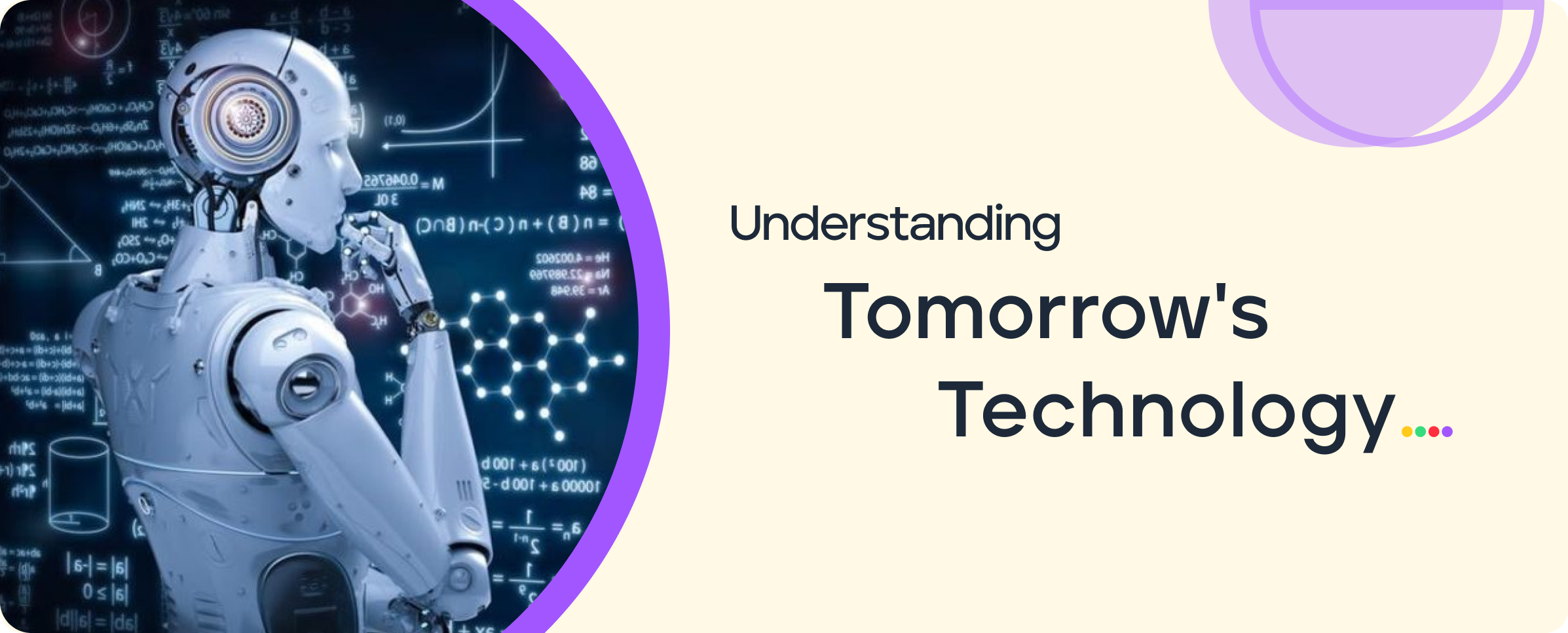Introduction
In a business landscape grappling with post-pandemic uncertainties, supply chain disruptions, and inflationary pressures, the imperative for strategic growth is more urgent than ever. Yet, as the threat of recession looms large, it’s clear that growth must be intelligent and technology-driven. Now is not the time for procurement leaders to rely on outdated methods; the stakes are simply too high. Whether your goal is to reduce costs, boost margins, or shift toward a completely new business model, one thing is crystal clear: mastering tomorrow’s tech is a must.
Navigating these complexities involves more than just staying ahead of technological trends; it’s about applying them in a way that is both effective and strategic. This article focuses particularly on the emerging technologies that procurement leaders must become familiar with immediately. According to Gartner’s annual list of technology trends, the next 36 months will usher in a range of transformative technologies that will be game-changers for both the tech-savvy and the business-oriented alike. We guide you through a comprehensive exploration to separate the hype from reality, concentrating on the technologies—from Generative AI to Blockchain—that will redefine procurement. Our goal is to clarify your tech priorities, offering both a panoramic view and an in-depth analysis of each technology, its relevance to your procurement operations, and how it fits into your broader strategic initiatives.
So fasten your seat belts as we delve into the must-know technological advancements that will not only revolutionize your procurement processes but also set your enterprise on a trajectory of robust, sustainable growth.
1. Generative AI – Crafting the Blueprint of Tomorrow’s Procurement
Since ChatGPT was launched in November 2022, the technology landscape has been in overdrive. McKinsey predicts that generative AI could contribute an astounding $4.4 trillion annually to the global economy. The technology’s rapid ascent—amassing 100 million users in a mere two months—signifies more than just its growth; it represents an unprecedented democratization of AI, positioning it as a vital strategic asset for procurement leaders.
Grasping the Potential: Tailored Use Cases for Procurement
For procurement leaders, understanding which use cases will bring the most value is crucial. Generative AI’s power isn’t just in automation but in ideation and strategy formation. It can analyze multiple data sources, such as real-time market data and emerging innovation trends, to generate prescriptive insights and recommendations for category managers. Beyond that, it’s also making waves in contract management. The technology can summarize lengthy contracts, offer alternative clause proposals, identify crucial clauses, and even draft contracts with recommended terms and conditions. It is a game-changer that reshapes how procurement functions can maximize efficiency and innovation. Below are some key use cases, tailor-made for the procurement sector:
Hyper-Personalized Buying Experiences: Generative AI can transform each purchase request into an intelligent, guided process, seamlessly integrating internal and external data to steer users toward compliant and cost-effective purchasing choices.
Streamlined Supplier Management: Generative AI optimizes the complex supplier management lifecycle, facilitating centralized communication and process acceleration—from supplier onboarding to performance assessment and improvement initiatives.
Strategic Category Management: Generative AI fortifies category managers by dynamically generating actionable insights from a combination of internal data and real-time market trends, helping identify optimization opportunities.
Proactive Risk Management: Generative AI doesn’t merely react to risk; it preemptively identifies it. Whether it’s geopolitical fluctuations affecting a supply chain or contract-related vulnerabilities, generative AI suggests mitigation strategies in real time.
For a more comprehensive view of generative AI’s impact in source-to-pay cycles, refer to the illustration below from Deloitte highlighting its highest potential in proactive approaches.
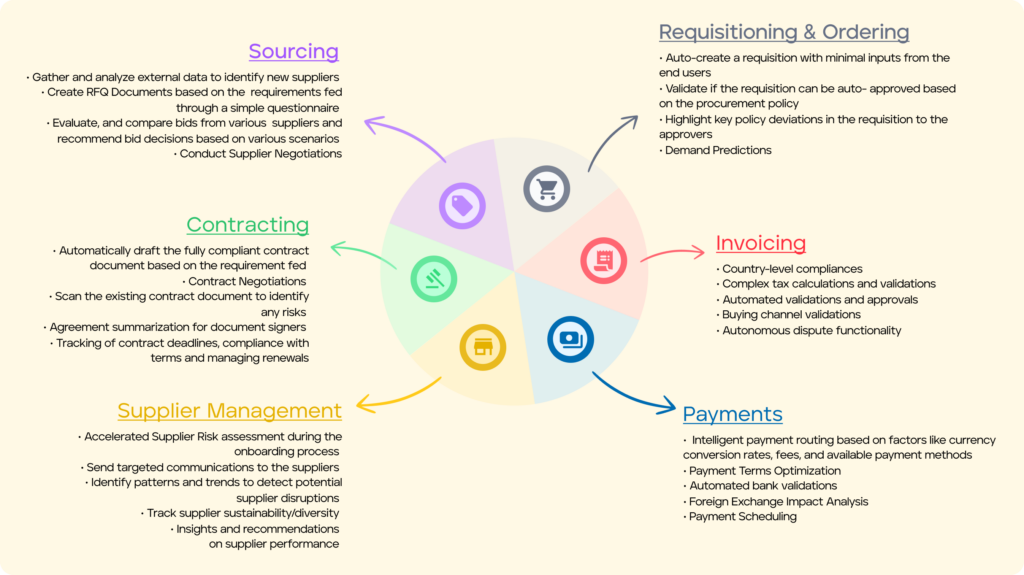
Risk and Reward: The Rapid Evolution of Generative AI
The velocity at which generative AI is evolving can’t be overstated, as illustrated in McKinsey’s timeline (see image below). While this rapid development brings immense opportunities, it also introduces complexities and risks, particularly around data ethics and integrity. However, the potential rewards are monumental, especially when strategically harnessed for transformative growth in procurement.
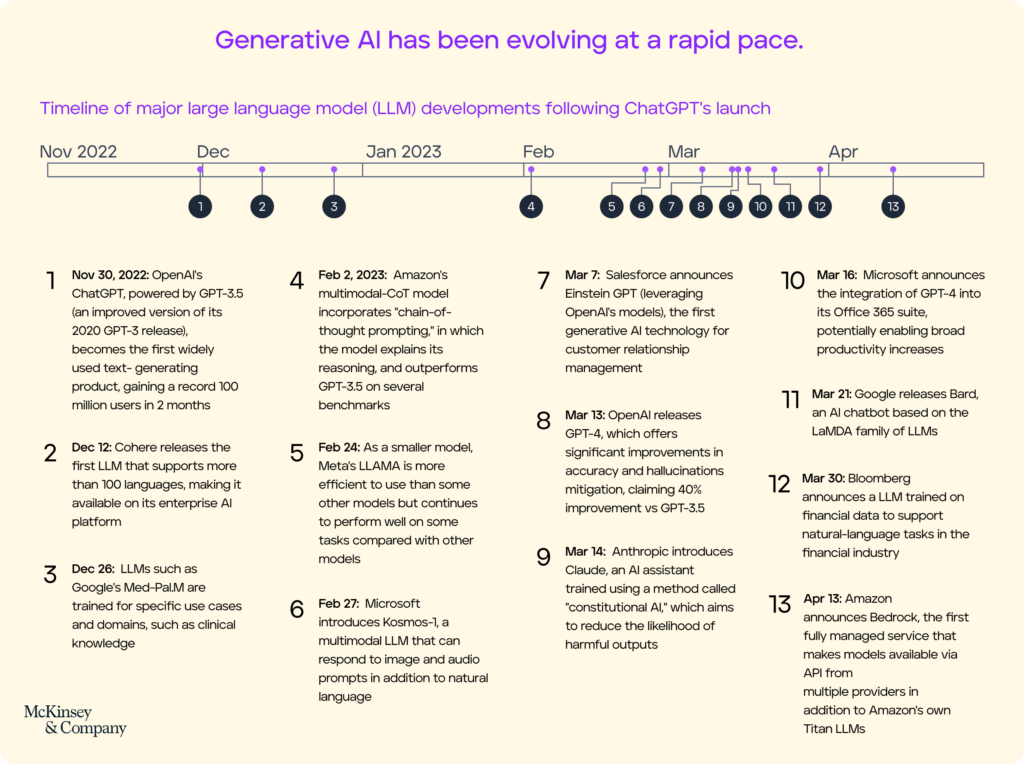
2. The Future of Intelligent Sourcing: Distinguishing Autonomous Procurement from Generative AI
In an era where technological advancements are happening at a breakneck pace, Autonomous Procurement carves its niche, notably appearing as a transformative innovation in Gartner’s Hype Cycle (see image below). Distinct from Generative AI, Autonomous Procurement is designed to fully automate the complete source-to-pay process across multiple spending categories. While Generative AI excels in generating insights, offering content, and assisting in decision-making, Autonomous Procurement aims to handle the full spectrum of procurement tasks autonomously, acting as an independently operating procurement division. This is revolutionary for the field of procurement, signaling a monumental shift in how procurement activities are conceptualized and executed.
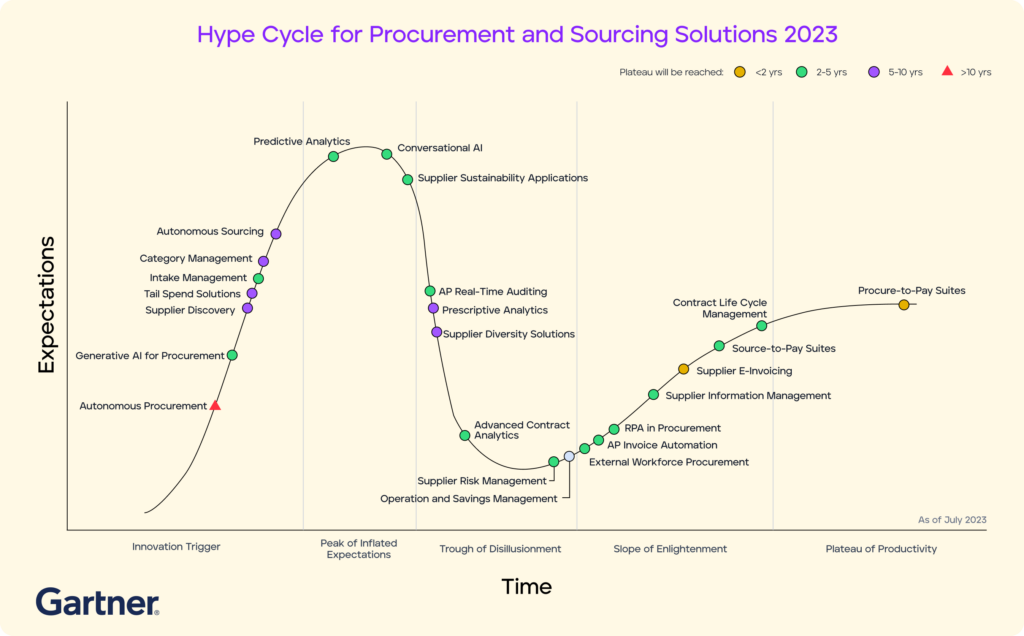
Unleashing Business Impact
The significance of Autonomous Procurement can’t be overstated. Its full-scale automation promises a high return on investment while enhancing compliance with organizational policies. By automating the entire procurement process, companies can reallocate human resources to focus on high-value tasks, thus transforming the essence of procurement operations. Immediate cost savings materialize from reduced labor, diminished non-compliant spending, and error minimization.
Diverse Use Cases to Consider
Autonomous Procurement offers a myriad of applications that promise to revolutionize the procurement industry:
• Automated Sourcing: Autonomously identify, evaluate, and choose suppliers for various procurement needs based on an array of parameters like cost, quality, and reliability.
• Dynamic Pricing and Contract Management: The system can negotiate and manage contracts in real-time, adjusting to market changes and ensuring the best terms.
• Autonomous E-Sourcing: I’ve observed in a recent demo by Penny Software, the system recognizes the product/services in a purchase request and suggests suppliers based on historical data. After gathering quotations, it compares and analyzes offers, identifies outliers, and makes negotiation recommendations.
• Real-time Risk Mitigation: Constantly monitors external and internal parameters to assess supply chain risks and suggests immediate counter-actions.
• Procure-to-Pay (P2P): A fully automated P2P function that selects what to buy, from whom to buy, and even completes the purchase orders.
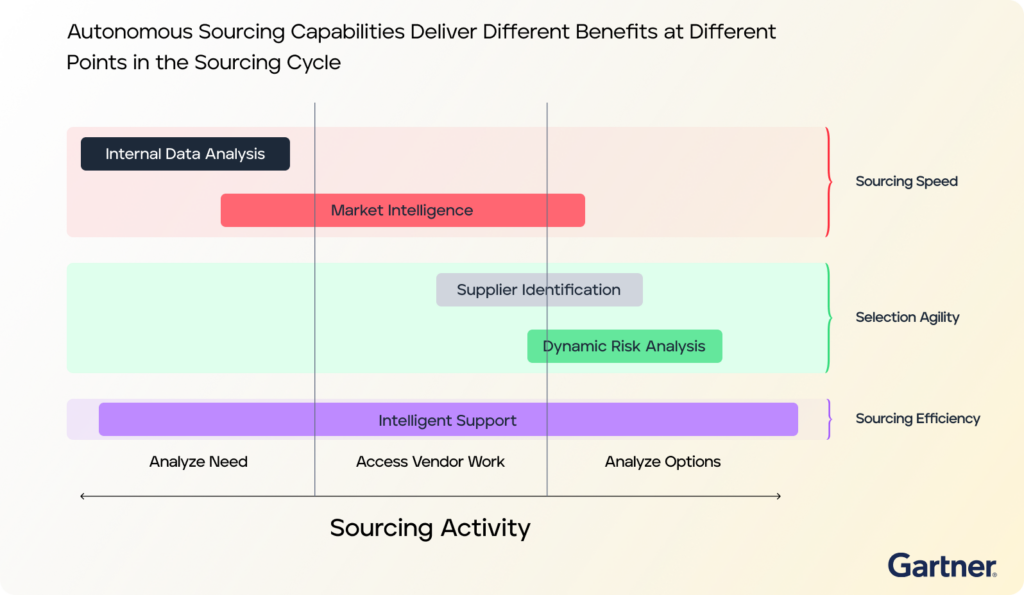
Autonomous Procurement’s strength lies in its large datasets, but this also implies the need for robust data security measures. Additionally, its limited experience in highly variable environments adds a layer of skepticism. However, the technology is ever-evolving, and more data and experience will likely overcome these shortcomings.
The velocity at which Autonomous Procurement is evolving, like its Generative AI counterpart, is staggering. Its insertion in the future of procurement is not just promising but inevitable, transforming repetitive, time-consuming tasks into automated processes that yield efficiency and cost-effectiveness. As organizations embrace this futuristic technology, they’re not just automating processes; they’re automating excellence.
3. Hyper-Automation – The Symphony of Speed and Precision
Building on our previous article, let’s delve into the groundbreaking sphere of Hyper-Automation. At its core, Hyper-Automation is an intricate blend of machine learning, packaged software, and a myriad of automation tools designed to revolutionize work processes. For procurement leaders, this technology presents an intelligent framework that empowers more agile, efficient, and data-driven strategies.
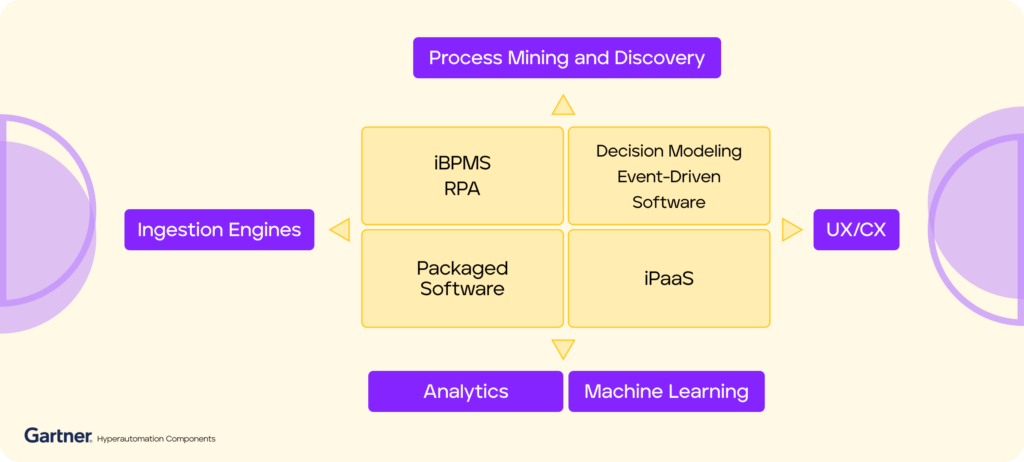
The Strategic Imperative for Procurement
Hyper-automation is far from a mere buzzword; it’s the pivot around which a new procurement paradigm revolves. It enables not just operational efficiency but also a new form of agile intelligence. The technology transforms your procurement function into a proactive, insight-led operation capable of making data-driven decisions in real time to navigate an ever-changing market landscape.
Financial Leverage and Beyond
The financial gains from Hyper-Automation are multi-dimensional. Beyond operational excellence, the technology enables more robust compliance, quality improvement, and a strategic focus that transcends traditional cost-cutting. These cumulative advantages pave the way for significant contributions to an organization’s bottom line.
High-Impact Use Cases
The real-world applications of Hyper-Automation come to life through its most potent use cases:
• Automated Strategic Sourcing: Cutting-edge algorithms autonomously analyze a gamut of variables—cost, quality, and supplier reliability—to either recommend or directly select the most advantageous sourcing avenues.
• Dynamic Pricing Optimization: Utilize real-time market data and predictive analytics to dynamically adapt procurement strategies and pricing, thereby maximizing value in fluctuating markets.
• Chatbots for Supplier Onboarding: Automated chatbots can streamline the supplier onboarding process, navigating complex documentation and administrative tasks with minimal human intervention.
• Automated Invoice Matching: The technology can automatically match purchase orders to invoices, flagging any discrepancies instantly. This not only reduces financial risk but also fortifies compliance measures.
Transitioning to a Hyper-Automated environment is not without its obstacles, such as the complexities around system integration and data governance. However, with strategic foresight and meticulous planning, these challenges become surmountable stepping stones on your path to transformation.
As a procurement leader, the time to act is now. The technology promises not just to upgrade but to transform your procurement operations fundamentally. So, the real question isn’t whether to incorporate Hyper-Automation but how swiftly you can do so to remain competitive.
4. Data and Analytics – The Oil of the Digital Age
As we elaborated in the previous sections on emerging technologies, Data and Analytics are the bedrock that allow organizations to elevate their procurement operations. They provide the essential structure for harnessing AI and machine learning to recommend and predict actions for more intelligent spending and supplier choices.
Unifying Data for Comprehensive Insights
While many procurement functions are solely focused on spending data, this approach offers only a myopic view of operations. To extract truly actionable insights, there’s a compelling need to create a “Single Source of Truth,” which consolidates data from across various functions like sales, finance, product development, and R&D. This data amalgamation is crucial for a comprehensive understanding of procurement (refer to illustration below from McKinsey & Company).
For data to become an actionable asset, it needs more than just gathering; it requires effective categorization. For example, merely aggregating office expenses won’t suffice. What’s needed is a detailed breakdown that allows for nuanced analysis—splitting costs across marketing, research, printing, and other categories.
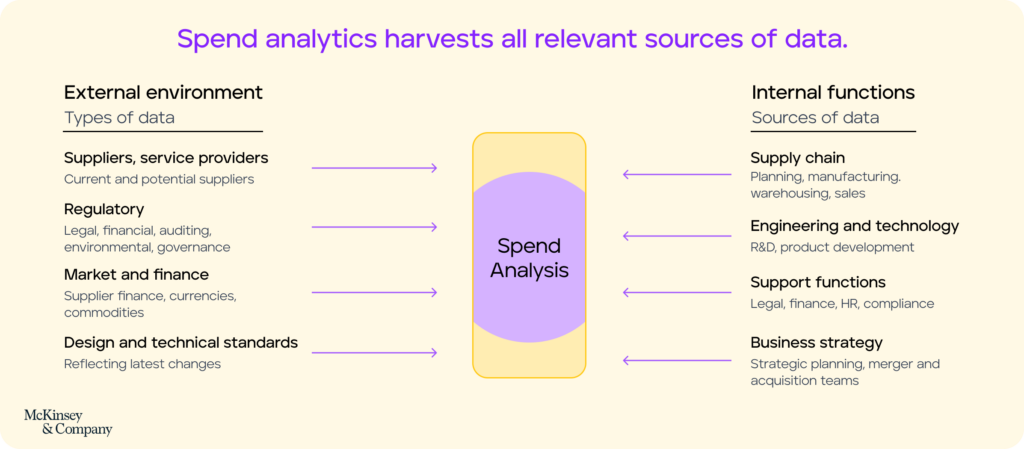
Key Use Cases in Data-Driven Procurement
• Supplier Risk Management: Assess multiple factors affecting supplier reliability, including financial and geopolitical conditions.
• Demand Forecasting: Utilize predictive analytics to anticipate demand and align it with procurement planning.
• Spend Analytics: Deeply analyze spending patterns to highlight inefficiencies and identify areas for contract improvements.
• Contract Compliance: Employ sophisticated text analytics to review supplier contracts for potential compliance risks
Levels of Data Analytics: A Gartner Overview
As depicted in the referenced Gartner diagram (refer to the image below), data analytics can be segmented into:
• Descriptive Analytics: Offers a retrospective review for informed sourcing and contract management decisions.
• Diagnostic Analytics: Drills down into the causative factors behind observed patterns or issues.
• Predictive Analytics: Forecasts potential future developments to aid in effective planning.
• Prescriptive Analytics: Provides action plans for achieving optimized outcomes.
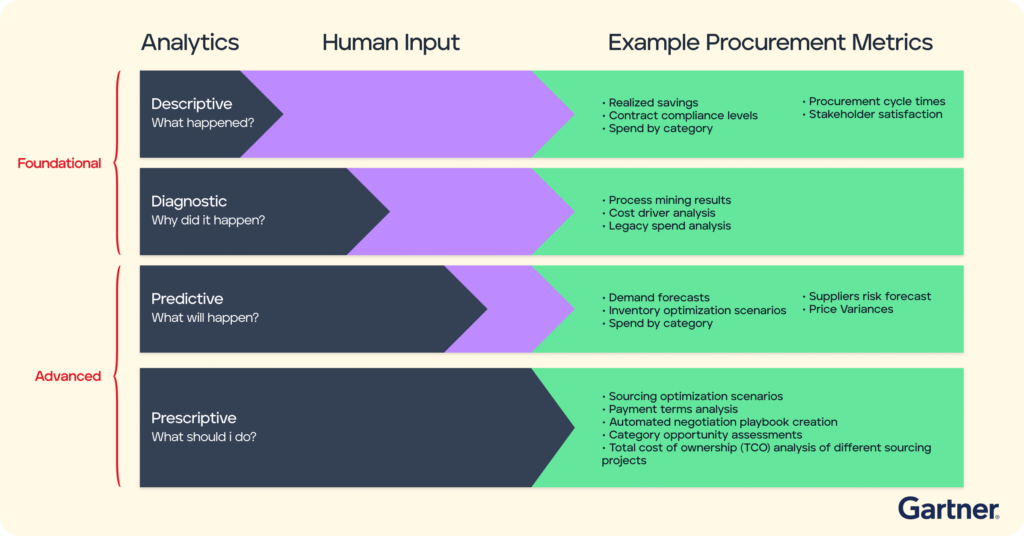
In a word, adopting a data-driven approach is no longer an option but a necessity. This approach not only grants increased visibility and potential cost savings but also contributes to effective risk management and strategic decision-making. Therefore, the imperative lies in shaping a clear data strategy, investing in suitable technology, fostering a data-centric culture, and collaborative supplier engagements.
By taking these steps, Data and Analytics transition from being optional tools to integral components of your overarching procurement strategy.
5. Blockchain’s Role in Revitalizing Procurement: A New Paradigm for Trust and Transparency
At first glance, the term ‘blockchain’ might sound like techno-jargon, a distant concept with little bearing on the day-to-day realities of procurement. But dig a little deeper, and you’ll discover a game-changing technology that is already shaping the future of transactions and data management. Simply put, a blockchain is an implementation of distributed ledgers that support a shared single version of truth based on immutable data, across multiple entities. While it’s making waves in various sectors, from finance to healthcare, its impact on procurement practices cannot be overlooked—even if it’s not yet universally adopted.
The Story So Far
To truly appreciate the role of blockchain in procurement, let’s start with the basics. Imagine a secure, unalterable digital ledger that records transactions across multiple computers. This is the heart of blockchain—a technology that offers unparalleled security and transparency, enabling every member of a network to track real-time updates. As procurement processes often involve multiple parties from sourcing to payment, blockchain’s promise of a ‘single source of truth’ brings a new level of integrity and transparency to the industry. Interestingly, according to PwC’s 4th Edition Digital Procurement Survey conducted last year, 59% of procurement departments believe that the applicability of blockchain in procurement processes still needs to be clarified. However, they see it as a valuable improvement vector for the entire supply chain
Why It Matters
Remember the time you were stuck verifying the authenticity of a product, or perhaps the long hours spent reconciling invoices? Blockchain can turn these cumbersome tasks into streamlined, automated processes. Beyond mere convenience, it plays a critical role in areas where traceability and transparency are non-negotiable—like food safety and pharmaceuticals.
The Plot Thickens: Real-World Application
Consider the Mitsubishi Chemical Group, a global leader in methacrylates. They launched a pilot project using blockchain to enhance sourcing capabilities and provide data on the true origins of all its products. The result was an unalterable, easy-to-access record of the entire chain of custody. Now, not only could they verify the quality of materials at every stage, but they could also offer their customers solid proof of product authenticity.
Looking Ahead
As with any narrative, the introduction of a disruptive element—like blockchain—paves the way for a new chapter filled with possibilities but also challenges. Early adopters are already experimenting with smart contracts, real-time tracking, and other innovative applications. The success stories, like the one from Mitsubishi, are piling up, and they all point to a future where blockchain could be the norm rather than the exception in procurement.
As illustrated in a recent McKinsey exhibit, blockchain has the power to do away with the traditional two- to three-day clearing process for financial transactions, offering a much more efficient and secure alternative. While the world has yet to see its full impact, the initial indicators are promising.
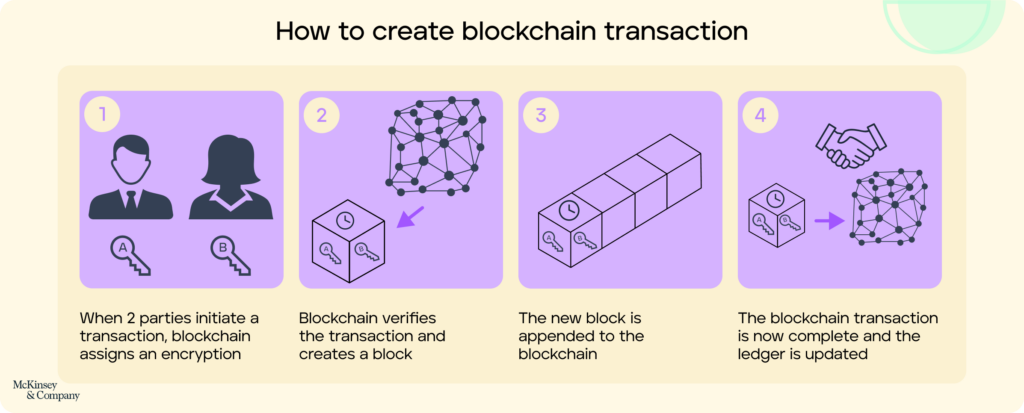
Before leaping into the blockchain bandwagon, organizations should conduct a thorough assessment of their existing procurement process. Like any innovation, it demands time, resources, and careful planning for successful implementation. Yet, for those willing to take the plunge, blockchain offers a powerful tool to optimize procurement, foster transparency, and ultimately deliver greater value.
In this rapidly evolving landscape, it’s not just about keeping up; it’s about staying ahead. And in the case of procurement, blockchain could very well be the next big leap forward.
6. The Unanswered Question: Why Aren’t We Fully Harnessing the Power of Digital Twin and IoT in Procurement?
In 2019, I asked a compelling question: “Why Aren’t We Using the Fusion of Digital Twin and Procurement To Generate Power Yet?” Fast-forward to 2023, and the query still stands, taking on even greater urgency. For the uninitiated, a Digital Twin is a real-time digital counterpart of a physical entity—be it an object, process, or even a whole system. It functions by equipping the physical component with smart sensors that capture real-time data about its status and performance. On the other hand, the Internet of Things (IoT) refers to the interconnected network of devices capable of collecting and sharing data. Both Digital Twin and IoT have shown transformative potential in sectors ranging from aerospace to manufacturing, yet their complete integration into the field of procurement remains a work in progress.
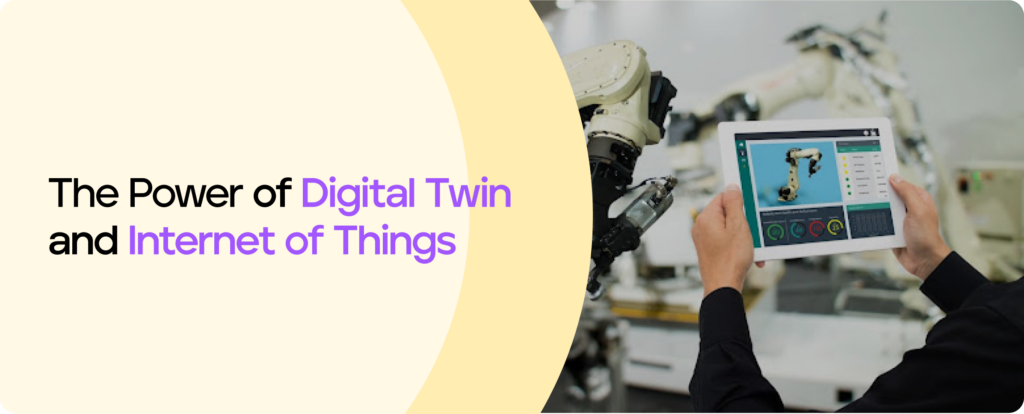
Let’s start by setting the scene in the procurement landscape. According to a Globality survey, more than 90% of global procurement leaders are rapidly evolving their operational processes and strategies, with a focus on new technologies like artificial intelligence (AI) and machine learning (ML). While most enterprises are making strides in adopting these technologies, a clear path to fully embracing Digital Twin and IoT technologies has not been laid. One significant hindrance is the lack of a unified view across supply networks. Disorganization and poor visibility into material inventory have made the transition toward more advanced, data-driven technologies a complex endeavor. However, Digital Twin offers a lifeline for these challenges. By simulating large, complex processes in real-time, Digital Twin technology not only provides a digital mirror of your physical inventory but also facilitates the organization and management of indirect materials like Maintenance, Repair, and Operations (MRO) supplies.
The promise of Digital Twin and IoT doesn’t stop at inventory management. When harmonized with AI and ML technologies, a new frontier for operational excellence opens up. Imagine a world where your procurement platform is not just a tool but a smart advisor that can autonomously execute orders, based on real-time data and predefined business rules. Such capabilities are no longer the stuff of sci-fi; they are within reach and provide an opportunity to automate tasks that have traditionally consumed enormous amounts of time and resources. Sensors attached to items in your inventory could send signals to the platform, which would then run forecasts and “what if” scenarios. These analytics can predict the item’s future performance and maintenance needs, thereby informing procurement decisions well in advance.
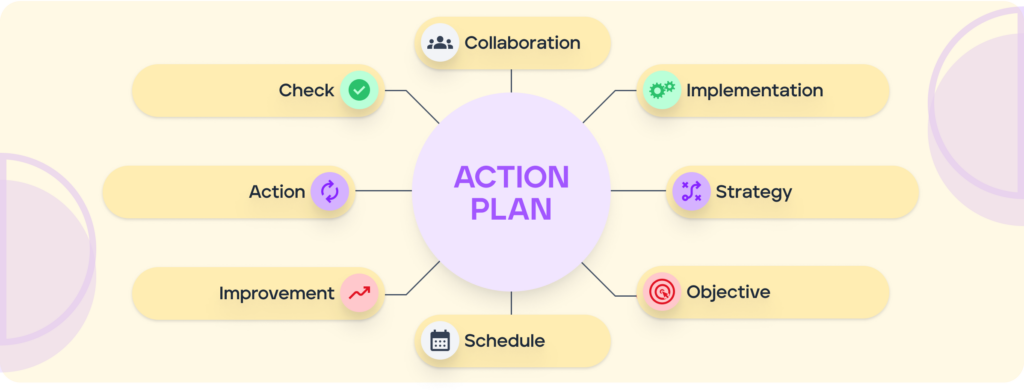
As we navigate this exciting intersection of Digital Twin, IoT, and AI, the potential for revolutionizing procurement becomes increasingly evident. Predictive insights could transition into prescriptive recommendations, offering not just a diagnosis but also suggesting proactive measures. Imagine if your procurement system could not only flag a degrading component but also recommend more efficient alternatives based on real-time data. Such a capability would not only optimize the procurement process but also open new opportunities for innovation and efficiency.
Conclusion: A Call to Action for Today’s Procurement Leaders
Our journey through this article underscores the imperative for procurement leaders to not just acquaint themselves with emerging technologies, but to become active participants in their implementation. From Generative AI to Autonomous Procurement, Hyper-Automation, Data and Analytics, Blockchain, and the dynamic duo of Digital Twin and IoT, each innovation is a game-changer in its own right.
It’s particularly encouraging to note that vendors in the procurement technology space are already delivering some of these capabilities. For instance, I’ve been genuinely impressed with Penny Software; their ability to quickly bring some of these transformative features to life is a testament to the speed at which the landscape is evolving.
As you contemplate your next moves, consider the benefits of each technology. Generative AI can stimulate creative problem-solving. Autonomous Procurement offers a new paradigm for source-to-pay operations, automating and enhancing the process. Hyper-automation goes beyond rudimentary automation to provide a seamless, end-to-end procurement experience. Data and Analytics give you the insight needed for timely, informed decision-making. Though not yet widely adopted, Blockchain promises unprecedented transactional transparency and security. Digital Twin and IoT extend the technological frontier, enabling predictive and prescriptive analytics that redefine inventory and operations management.
The future is not waiting. Those who don’t adapt risk falling irretrievably behind. No longer is the question merely about if these technologies should be part of your strategy, but how swiftly you can integrate them to create value and competitive advantage. Amidst this urgency, a technology procurement leader faces a critical challenge: meeting stakeholders’ needs for speed to achieve business outcomes while simultaneously mitigating risk and reducing costs. If you’re still asking, ‘Why aren’t we leveraging these groundbreaking technologies?’ know that the time to act is now. The future of procurement isn’t a distant prospect; it’s already unfolding before us.
